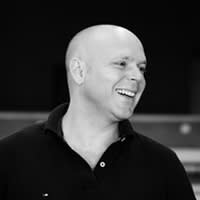




Diverse People, Diverse Perspectives
Waracle is an inclusive, inspiring & developmental home to the most talented and diverse people in our industry. The perspectives offered in our insights represent the views and opinions of the individual authors and not necessarily an official position of Waracle.
Key Insights


It’s a hot topic among executives; how to build more valuable customer experiences by establishing product teams and embedding a product mindset across your organisation. However, this shift can be challenging for traditional enterprises with deep-rooted project practices and perspectives.
As a leader, knowing when a product approach is suitable for your organisation and how to support your teams in this transition is essential. This article summarises some of the challenges and implications of moving from project to product thinking.
What is a product team?
An ideal product-mode team is an empowered, outcome-oriented, business-capability aligned, long-lived, cross-functional, ideate-build-run team that is able to and expected to solve problems and improve business outcomes.– Sriram Narayan
Agile product teams focus on realising a business or customer outcome and put the customer experience at the heart of achieving that outcome. To do this, they must be afforded the autonomy to learn about the customer’s needs through customer research, interviews, and surveys and use these learnings to create an effective product strategy that will help them achieve the desired outcomes.
Product teams are cross-functional teams including but not limited to Product (Product Managers/Owners, Design, Marketing, Research), Technology (Devs, QA, DevOps, Support), Legal, Compliance, Sales, Operations and HR. However, this team structure enables product teams to operate with minimal dependencies and cross-organisational orchestration, promoting faster iteration, speed to market and experimentation.
The long-lived nature of product teams is a significant departure from the project perspective. The team continues to learn, evolve and optimise their solutions for as long as the organisation requires that business capability. This significantly reduces the time and effort needed to form a brand “new” team every time there is a new product requirement.
Finally, the Amazon mindset of “you build it, you run it”, popularised by Werner Vogels, is at the heart of product teams. They are entirely responsible and accountable for the solutions they develop. If this means someone gets woken up by a pager in the middle of the night because a production system has gone down, you’ll probably notice an increase in automated testing in the following days!
The shift to product is not as easy as it sounds


The move towards products is a massive cultural shift for any enterprise. It changes responsibilities, spheres of influence and accountabilities in ways that can be disconcerting for some, but incredibly empowering and rewarding for others.

Gary Crawford
Chief Innovation Officer
While this shift might make logical sense to any executive reading this article, it’s a significant departure from the reality of traditional enterprise approaches. Let’s take a deeper look at where these differences may raise eyebrows in the enterprise.
Outcomes over Outputs
Project thinking is focused on delivery, while product thinking is focused on the outcome. For this reason, Product teams are better placed to see and respond to strategic opportunities, while project teams focus on the tactical delivery of defined scope. Product teams benefit from having access to the broader vision and can experiment with new features or services that open up more possibilities. In contrast, project teams are more suited to moving quickly through a predetermined list of activities and tasks.
Tactics is knowing ‘what to do’ when there is ‘something’ to do. Strategy is knowing ‘what to do’ when there is ‘nothing to do’. – Savielly Tartakower, Chess Grandmaster
Long-term over Fixed-term Duration
Product teams differ from projects because they are near-permanent teams lasting for as long as the digital product is required. The budget is sufficient to continuously fund a durable product team for the product’s lifecycle. This is in recognition that nothing remains static; customer needs change, business needs change, market expectations change, and technologies change. A product team can continually respond and optimise in the face of this flux.
On the other hand, project teams have a fixed scope, fixed budget and, in turn, a fixed duration for the team to work together to deliver the planned tasks.
This change in funding can be challenging to explain in traditional enterprises with a significant organisational investment in PMOs, financial management and governance that reinforces the project mindset and have grown to love RAG status and reports that say “done!”.
Sense and Respond over Follow the Plan
Experimentation and learning are at the heart of product approaches. The self-contained nature of product teams supports this because they can reorient themselves quickly, reduce end-to-end cycle time and iterate at pace. In short, learnings from experimentation can often be integrated into production products within hours.
On the other hand, project teams can’t easily move out of scope delivery because they are usually only meant to “build” the solution.
Customer-centric over Plan-centric
Product teams put the customer (internal and external) at the heart of their exploration and delivery. Success is measured by meeting customer needs and realising customer value.
Project proponents will say that the customer is at the heart of their plan. However, this is built on the assumption that the program has considered and effectively addressed every possible outcome, need and behavioural quirk of the human users of the products we develop. Don’t assume that successful progress through a Gantt chart means that customer and business outcomes will be met!
Validation over Projected Benefits
Product teams, specifically the product owners can prove the benefits of the products built using A/B testing, analytics and various other feedback systems to validate the actual benefits of the product by measuring the KPIs (Key Performance Indicators), which might not be done in projects. Projects are more delivery focused, however, products are validated often and frequently by means of testing and making adjustments to the product increments, which increases the overall efficiency of product teams.
Autonomy over Direction
Product teams have greater autonomy and purpose than typical scope-delivery project teams. This is typically welcomed by subject matter experts, but it can be disconcerting for those more comfortable with a traditional PMO background.
Team-level ownership of code and systems allows for more controlled evolution of systems. The ability to rapidly move from one version of a system to another in short release cycles gives teams the freedom to experiment with ideas and find out what works best for users.
Making the transition to product teams
A good number of product teams actually start out life as a project, especially with the inception of a new product of service. From the discovery phase through to construction there are a number of required actions and activities to be successfully completed to achieve the launch date, but as any good product leader knows the launch is just the beginning.


The transition from Project to Product is one of the most overlooked elements, as most project teams focus on the end goal of completion. But months and even years of hard work can be undone if there isn’t the foresight to look beyond the launch

Matt Nicholson
Head of Product
Blasting off into space and then successfully plotting a course to your destination needs a different set of skills. In today’s world it is not economically viable to run two sets of teams, nor is it a good idea – the best people to manage a product are the people that built it, with those organisations that have adopted product-oriented approaches like DevOps seeing higher quality, faster time to market and improved communication and collaboration (Atlassian DevOps Trends 2020). So transitioning the project team to a product team is imperative, but it comes with its own set of challenges. You must retain the skill set and knowledge it has taken to get your product to market, but you also need to flex and bolster it with additional skills for it to survive and flourish in the wild, something that is not easily done. Becoming a product team should be the aspiration of any project team and should be a metamorphosis throughout the project, otherwise you might find after the cheers fade from a successful launch everyone is looking round asking each other: “what’s next?”.
Conclusion
A product team is cross-functional, incorporating product, technology, sales, legal, compliance and HR skills. These teams are long-lived, continuing to learn and evolve. They should be autonomous in their learning about customer needs and use this knowledge to make decisions that will help them achieve their goals. Product teams can guide and support organisations in their product delivery & transformation across the entire product lifecycle (strategy, development, growth, maturity and decline).
To create successful products that customers love, it is essential to have autonomous and empowered product teams that can make decisions to ship the best product possible.
Knowing how to build a product is one thing but knowing how to build a product team that can support its growth and maturity is another. From project to product Waracle’s reputation is built on helping its clients build the right team for the right part of their product’s journey. If you want to know more or need guidance with your own transformation, get in touch!
Authors
Head of Design
Senior Business Analyst
Principal Technical Consultant
Head of Product
Related

Article • 09 December 2025
From sandbox to squad: AI-enhanced delivery in practice

Article • 05 December 2025
The art of applying stoicism to sales craft

Article • 26 November 2025
Why data infrastructure delivers value regardless of market direction

Article • 24 November 2025
Waracle accelerates growth with acquisition of Sofia-based Hacksoft

Article • 14 November 2025
Waracle secures long-term digital transformation deal with People’s Partnership




